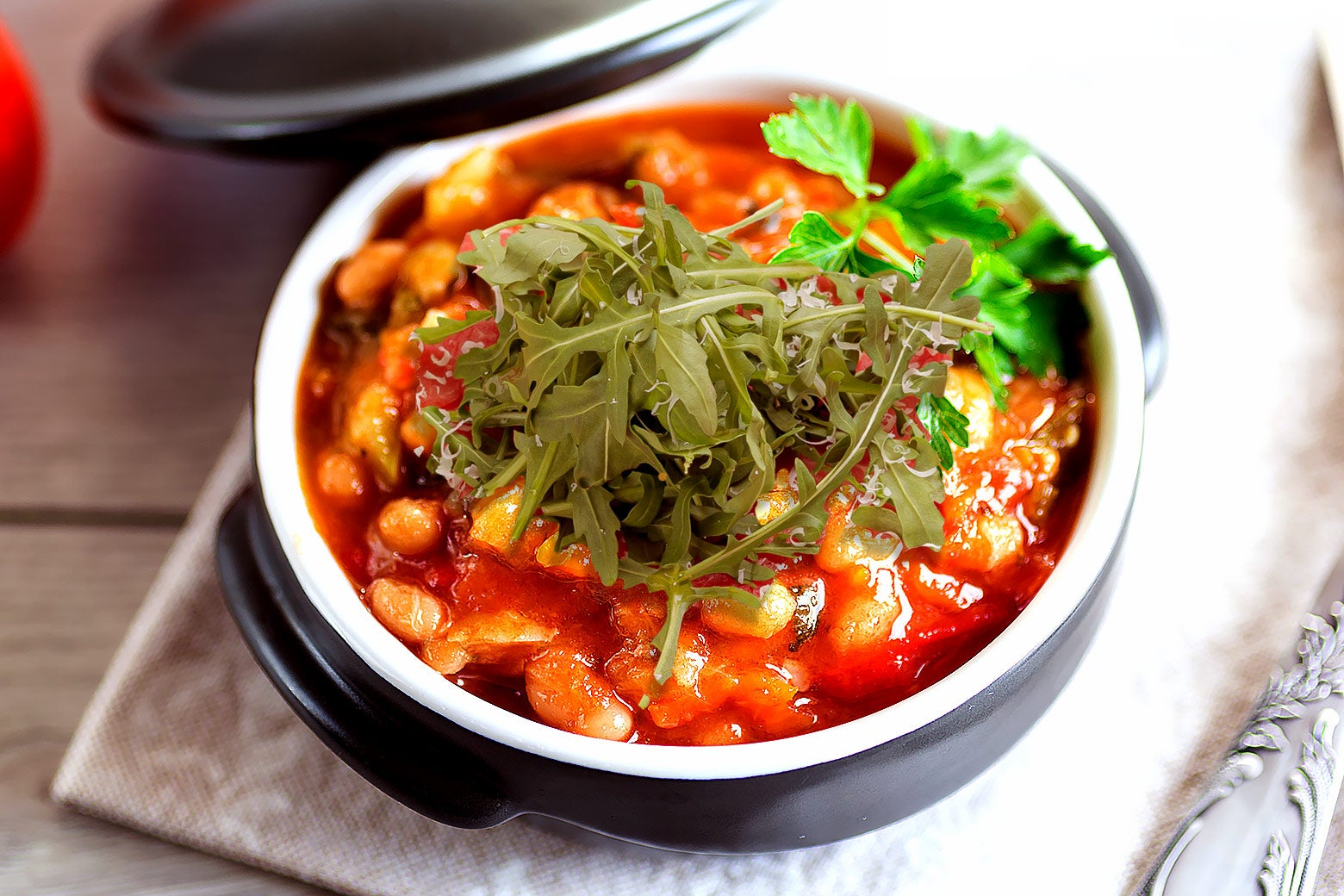Sign up for the Slatest to get the most insightful analysis, criticism, and advice out there, delivered to your inbox daily.
On Tuesday evening, my phone erupted with a notification that, for once in the last hellish month, was not about the forced implosion of the American system of government: “These beans went viral,” the New York Times Cooking app proclaimed. Hmm, viral beans, in this quad-demic? I love beans, so following my reckless curiosity, I tapped through. But I needn’t have bothered—these were those beans, the “Creamy, Spicy Tomato Beans and Greens” that everyone has been losing it over for the past month.
When you look at the recipe, from senior staff editor Alexa Weibel, you may notice that it was originally published in April of last year. It is not new! Indeed, it was one of the paper’s most popular recipes of 2024, but it seems only to have become “The Beans” to online fans in recent weeks. I started seeing them on Instagram in the latter days of January, and there’s a popular Reddit rave from Jan. 29: “I have ascended. I have seen the face of true comfort, and it is this dish. I took one bite, and suddenly, all was right in the world.” The Times savvily capitalized on this enthusiasm with a Feb. 6 Cooking newsletter, spurring a virtuous cycle of buzz among influencers and on social media, particularly Reddit, where there is a thriving “megathread” dedicated to celebrating The Beans and divining their secrets. Countless skillets are undoubtedly simmering away across the country as we speak.
Just what is it about The Beans that makes them so transporting? We can stipulate from the start that they are very good. But ascension good? After happily chewing on them for a few days (excellent leftovers!), I think I have an idea—a humble contribution to Beanology I’d like to share.
At first glance, what we have here is one of those weeknight-friendly, pantry-staple toss-togethers, composed primarily of white beans, tomato paste, and cream, with a jaunty little arugula salad hat. The Beans benefit from truth in advertising—they are indeed creamy (from both the flesh of the partially collapsing beans, and dairy), a little spicy (red pepper flakes), and contain an enjoyable amount of the three named ingredients, not to mention a shower of fried breadcrumbs and pecorino. But there’s a flavor element here, one that emerges only in the final, combined bite, that I believe is the true reason for all the hoopla: The answer to The Beans’ allure, I submit to the committee, is tang.
The Beans are tangy! Some readers will immediately know what I mean by this, but my research suggests that tanginess is undertheorized and not widely enough appreciated. Indeed, I consulted a number of my cooking reference books—the Diner’s Dictionary, the Flavor Thesaurus, the Flavor Bible itself—and found not one entry. Google will return general definitions that are kind of all over the place, circling around the idea of sourness or, even more vaguely, a sharp or strong flavor. But these are facile and inadequate—we can do better.
The lone description for tang that I could find online that actually gets us anywhere comes, interestingly enough, from a website about tea: “An intensely piercing sweet and sour impression along the sides of the tongue.” What I like about this is that it conveys not only the basic taste buds involved, but also something like mouthfeel. And in my experience as a lover of the tangy—my palate was shaped in the South, where tang infuses much of the cuisine, from mustardy Carolina barbecue to collard greens, to coleslaw—it is not just a flavor, like sour or bitter, but a whole-mouth phenomenon.
So, the first expansion I’d propose to our understanding of tang is that, yes, it is sour or acidic, but the full sensation is one of those flavors cutting through fat. There may or may not be sweetness or spice involved (though, for me, a certain sense of sweetness often accompanies the presence of fat in a dish), but there is always that feeling of something bold and biting, “piercing,” as the tea people put it, through some unctuous resistance.
I mentioned BBQ—there, we have the zip of the mustard playing against the fatty pork. With slaw, it’s vinegar against mayonnaise (preferably Duke’s, which has “twang” right there on the bottle). In the case of The Beans, tang’s incursion comes—and this, I think, is the key to its star power—from an unexpected source: sun-dried tomatoes. Reader, I will admit that when I noticed this ’80s throwback in the recipe’s ingredient list, I was skeptical; I almost left it off my shopping list. When I did get a jar home, I tried one directly, and it was a revelation unto itself—bright, acidic tomato dancing through the olive oil. (Tip: Buy high-quality oil-packed varieties, such as Alessi, to avoid the dusty commercial flavor that haunts so many of us who ate these back in the day.) And in The Beans, the tomatoes, which are chopped and added before the simmer, do a similar little jig, singing through the cream. In a dish that I had expected to be pure comfort mush (+ salad), this note of tang was a little thrill, like a handsome stranger catching your eye across the bar, if the stranger were a confit of desiccated tomatoes and your eye was your tongue.
This is probably getting to be enough words about some tangy beans, but I can’t resist adding a few parting thoughts. Like handsome strangers, tang leaves you wanting more. Its presence in your mouth is striking, jarring, almost uncomfortable; as with very spicy foods, you may find yourself desiring to repeat the zap, spoonful after spoonful—people certainly have had this experience with The Beans. And last, a provocation for us to ponder: The more I reflect on it, the more I think tang almost tastes … spoiled. There’s a whisper of something off about it, a visceral riskiness that stirs and titillates as acid transgresses fat. (The combination of these two elements can, after all, turn into something rancid.) Could this kill me? your brain stem asks. No. But that it doesn’t, that you’ve eaten on the edge and survived, is maybe where the pleasure lies.
Or maybe I’m reading too much into it. They’re just beans. Regardless, I think we could all use a little brightness and sensual excitement in our lives right now. So recipe writers, listen up—more of this, please! We promise there’s viral gold in them tangy hills.
















